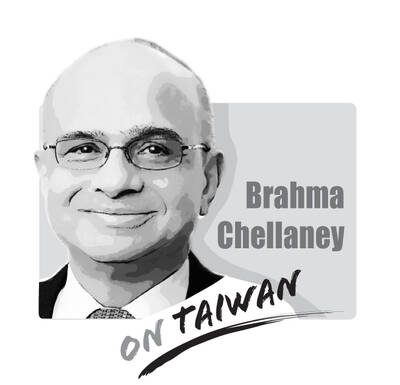Data released by the Chinese National Bureau of Statistics on Friday showed that China’s GDP growth slowed to 6.5 percent in the third quarter, the lowest since early 2009. China’s growth faces increasing pressure from the US-China trade war, Beijing’s financial deleveraging and property curbs, the US Federal Reserve’s interest rate hikes and a weakening yuan that is prompting capital outflows.
The People’s Bank of China has lowered its reserve requirement ratio four times to encourage lending and has urged banks to increase lending to cash-starved small companies, but Chinese media have reported that banks’ loan requirements for small firms and private companies remain stringent, and further reserve requirement reduction is expected.
Chinese equities have fared worse than other Asian markets this year, with yuan-denominated A-shares in Shanghai last week falling to a four-year low. Worries about the forced sale of pledged shares spiked last week after firms said that their major investors had failed to meet demands for additional collateral.
As more forced sales would tip the markets into a downward spiral, Chinese regulators have called on creditors to prevent them, while a number of state-run funds and local government-backed enterprises have injected funds into listed firms facing forced liquidation of pledged shares.
Government intervention in the stock market is a sign of commitment to maintaining market stability, restoring investor confidence and pumping more liquidity into the market, yet the latest tallies compiled by China International Capital Corp show that by last month, 26 companies listed in Shanghai and Shenzhen had sold controlling stakes to central, provincial or city governments, as they could only access capital through the state. This has triggered discussions about public versus private ownership of businesses and speculation that the Chinese Communist Party (CCP) might sideline the private sector and advance the state sector.
The speculation dates to January, when Zhou Xincheng (周新城), a professor at Renmin University of China’s School of Marxism Studies, advocated developing the public sector in CCP political theory journal Qiushi (求是), calling for the elimination of private property.
His words caused a massive splash on Chinese social media, but Beijing authorities at the time kept to the sidelines.
Eight months later, Wu Xiaoping (吳小平) in an article on the Jinri Toutiao (今日頭條) Web site said that the private sector had fulfilled its task and should gradually wither to make way for a fully fledged state-run economy.
This time, facing a wave of public criticism, ranking Chinese officials and state media said that the two sectors are interdependent and the private economy would only grow bigger.
Apparently, Beijing is trying to assure the public that it supports the private sector — which makes up more than 60 percent of China’s GDP — and does not want any reactionary ideas to question its reformist agenda and policy of opening up the economy at a time when it is already facing headwinds.
However, it remains to be seen whether expanding the state’s influence on the private sector and squeezing out private firms are mere debate topics or a policy agenda in the making. After all, China’s idiosyncratic economic environment often defies conventional thought about capitalist markets.
Policy risk is one more potential headwind facing the Chinese economy, and foreign businesses, including Taiwanese firms, that are planning to invest or expand operations in China should take note.

Taiwan stands at the epicenter of a seismic shift that will determine the Indo-Pacific’s future security architecture. Whether deterrence prevails or collapses will reverberate far beyond the Taiwan Strait, fundamentally reshaping global power dynamics. The stakes could not be higher. Today, Taipei confronts an unprecedented convergence of threats from an increasingly muscular China that has intensified its multidimensional pressure campaign. Beijing’s strategy is comprehensive: military intimidation, diplomatic isolation, economic coercion, and sophisticated influence operations designed to fracture Taiwan’s democratic society from within. This challenge is magnified by Taiwan’s internal political divisions, which extend to fundamental questions about the island’s identity and future
The narrative surrounding Indian Prime Minister Narendra Modi’s attendance at last week’s Shanghai Cooperation Organization (SCO) summit — where he held hands with Russian President Vladimir Putin and chatted amiably with Chinese President Xi Jinping (習近平) — was widely framed as a signal of Modi distancing himself from the US and edging closer to regional autocrats. It was depicted as Modi reacting to the levying of high US tariffs, burying the hatchet over border disputes with China, and heralding less engagement with the Quadrilateral Security dialogue (Quad) composed of the US, India, Japan and Australia. With Modi in China for the
The Chinese Nationalist Party (KMT) has postponed its chairperson candidate registration for two weeks, and so far, nine people have announced their intention to run for chairperson, the most on record, with more expected to announce their campaign in the final days. On the evening of Aug. 23, shortly after seven KMT lawmakers survived recall votes, KMT Chairman Eric Chu (朱立倫) announced he would step down and urged Taichung Mayor Lu Shiow-yen (盧秀燕) to step in and lead the party back to power. Lu immediately ruled herself out the following day, leaving the subject in question. In the days that followed, several
The Jamestown Foundation last week published an article exposing Beijing’s oil rigs and other potential dual-use platforms in waters near Pratas Island (Dongsha Island, 東沙島). China’s activities there resembled what they did in the East China Sea, inside the exclusive economic zones of Japan and South Korea, as well as with other South China Sea claimants. However, the most surprising element of the report was that the authors’ government contacts and Jamestown’s own evinced little awareness of China’s activities. That Beijing’s testing of Taiwanese (and its allies) situational awareness seemingly went unnoticed strongly suggests the need for more intelligence. Taiwan’s naval